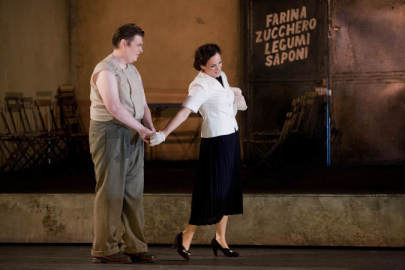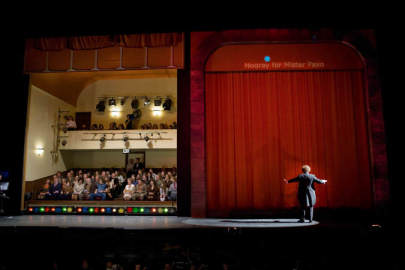Other Links
Editorial Board
- Editor - Bill Kenny
- London Editor-Melanie Eskenazi
- Founder - Len Mullenger
Google Site Search
SEEN
AND HEARD OPERA REVIEW
Mascagni/Leoncavallo, Cavalleria rusticana &
Pagliacci:
New
productions by Richard Jones and designed by Ultz. Soloists, Chorus
and Orchestra of English National Opera. Conductor: Edward Gardner.
The London Coliseum, London. 26.9.2008 (JPr)

Robert Ewens as Turiddu's brother,
Fiona Murphy as Lola
Although most recently seen as a Raymond Gubbay Royal Albert Hall
extravaganza, Cavalleria rusticana and Pagliacci, or
‘Cav & Pag’, have not been seen together in London’s main opera
houses for quite some time. They once were as popular as the
regularly performed Puccini operas or genuine Verdi masterpieces (Rigoletto,
La Traviata, Un ballo in maschera, Aida etc.)
in the affections of opera lovers. Recently they have fallen out of
favour somewhat and perhaps a reassessment of them is overdue?
Modern audiences seem to get an overdose of naturalism whenever the
houselights dim in a theatre or opera house these days and so these
operas, with their tales of love-triangles and bloody revenge, can
be easily written off as mere lurid melodramatic potboilers.
In Cavalleria rusticana (‘Rustic Chivalry’) we have the
soldier Turiddu who is sleeping with Lola, the wife of the local
cart-driver Alfio,
while he is away; and
also cheating on his girlfriend
Santuzza, who begs him to give Lola up.
When he refuses, she tells Alfio the situation
and he kills Turiddu in a knife fight. Mascagni rarely wastes
a second of this 75 minute opera of almost symphonic beauty.
Richard Jones acknowledges this when he calls Cavalleria
rusticana ‘a conductor’s piece’ -
comparing it with Pagliacci (‘Clowns’),
‘a director’s piece’. That
may well be true but Pag is also a
singer’s piece. This is clear from
the moment that Tonio steps from behind
the curtain to sing the opera's famous prologue ‘Si puo?’ Tonio is
the crippled clown in a travelling commedia dell’arte troupe
which stops for a night in Calabria. There
Nedda, the beautiful wife of Canio, the troupe's intensely
jealous leader, is reunited with her secret lover, Silvio, and they
make plans to run off together after the performance. Tonio, whose
advances Nedda has scorned, overhears their plans and tells Canio
about his wife's betrayal. While they are performing a stage farce
(also about a wife's betrayal)
which mirrors the offstage
love triangle, Canio stabs both Nedda and her lover Silvio,
who has leapt onstage to save her, to death.
Like
Mascagni, Leoncavallo possesses the basic essentials for writing a
successful opera; he has a strong sense of colour, the feeling for
melody, dramatic force, declamatory power, and musical
characterisation. Here again the action of the drama never flags.
This is not to say everything is perfect as Leoncavallo has his
faults. His music often recalls other composers, Wagner included,
his emotional gear changes are occasionally over-exaggerated and his
orchestration a bit noisy. On the other hand, his dramatic grip is
greater than Mascagni’s, as is his power of characterisation.
What might Richard Jones,
one of today’s leading figures of ‘director’s opera’, make of
these stories? The more I am distanced from his production of the
Ring Cycle of the late 1990s at Covent Garden the more wonderful
are my recollections of it. There are many other iconoclastic yet
illuminating Jones stagings
which I have enjoyed including a brilliant
early Das Rheingold for Scottish Opera, his fantastical
Hansel und Gretel for Welsh National Opera, a visceral
Lulu for English National Opera and an electrifying
Lady Macbeth of Mtsensk
at Covent Garden. I anticipated an evening to remember and he did
not disappoint me.
Cavalleria rusticana
(‘Sicilian Revenge’ as Sean O'Brien new translation calls it) is the
more unremittingly dark of the two short operas. Eventually the
audience realises less money has been spent on this work, and less
directorial effort too it seems, yet its unfolding drama is gripping
from beginning to end. The ENO warehouse has been raided and use has
been found for a low one-storey set from their abandoned Ring.
We are clearly where we should be in Sicily although not
outdoors but in a claustrophobic, much-used, 1930s dirty tin-roofed,
community hall/soup kitchen. Here the women gather to make rabbit
stew for after Easter Sunday Mass. It is a closed community where
every minor indiscretion becomes public knowledge.
Easter Sunday happens outside the hall but religion heavily
influences the happenings within it. During the prelude Turridu
meets Lola for sex and then his ‘offstage’ serenade at the opening
of the opera is sung directly to her. Yet directorial sloppiness
here (which does not happen in Pagliacci) has neither Lola’s
dress dishevelled nor Turridu needing to adjust his trousers. The
wronged woman, Santuzza, seems an embittered outsider, pregnant
before marriage, who has lost the respect of the community. However
it becomes ‘all for one and one for all’ as Alfio gets his bloody
revenge when Turridu’s eyes are gouged out and he is stabbed before
dying in Lola's arms once again. It is left to the invented
character of Turridu’s ‘brother’ with cerebral palsy to scream that
he has been killed.
My only criticisms are that the single set often gets rather crowded
and that the translation is a little contrived at times ‘Back home I
know Lola’s pining, but soon we’ll be combining’ and some single
words are spread unmusically over too many notes -
‘hon-on-our’ and ‘fore-ev-ver’ were just two jarring examples.
From his first aria, Peter Auty’s
heavy drinking and abused Turridu was an ardent interpretation, with
warm heroic tones and ringing secure top notes. He was at his best
in ‘Mamma’ as he said farewell to his mother. He did not seem the
best of actors and looked strangely child-like in his blue trousers
and boots. Jane Dutton who impressed me last year at ENO as Amneris
sang Santuzza with great heart; she was wonderfully neurotic and
hungry for revenge. As Alfio Roland Wood was rather dry-voiced and
failed to fill the theatre with sound and Fiona Murphy’s Lola was
only intermittently seductive.

Pagliacci
The sense of character was outstanding and it was as if I had known
them all my life; Tony O’Sullivan (Tonio), Kenny (Canio), Nelly
Scrimshaw (Nedda) and Silvio (Woody, the stage carpenter). When
Kenny begins his tragic aria ‘On with the make-up’ Jones (and his
designer Ultz) show him and the other leading characters
side-by-side in their small grimy dressing rooms and sadly we
remember all those comics of yesterday for whom there was always
sadness behind the laughter and smiles. I remembered particularly my
own backstage visit once to meet Ken Dodd.
The sets were a marvel from the company’s arrival at what possibly
is the Sunderland Empire of the 1970s, through onstage and
backstage views of the theatre and to the final scene where the
‘auditorium’ fills half the stage and we have the bedroom farce
carrying on as people would see it in the other half. In the final
moments we have stage action and audience’s reaction brilliantly
shown together. As matters reach their deadly climax and the
swearing begins ‘You better f****** tell me what’s his name’ as
Kenny demands answers from Nelly, we see shocked parents, relatives
and children leaving their seats and going home. Kenny shoots Nelly
and Woody before dispatching himself with a shot through the mouth.
Jones has Kenny sink down on stage very much as Tommy Cooper did
when he died during a live TV broadcast - with some laughter
still resounding from those who - as here - think it is still part
of an ‘act’. Though never has Kenny’s final spoken ‘The comedy is
over’ seemed less of a laughing matter.
With its more compelling story, stronger cast and subtler direction
Pagliacci is undoubtedly the stronger half of the double bill
but then, don’t we really expect that? The adaptation never seemed
to work against the opera even when Kenny sings ‘Laugh Mr Paxo’. The
greatness of this staging is to take these characters who are real
enough anyway and then truly make them live.
Mary Plazas’s vivacious comedienne Nelly sparkily sings her aria,
‘The birds where are they going?’ as she rehearses her show-stopping
song dancing with a cane, in scarlet dress and silver heel heels.
She is also a compelling actress in lingerie during the bedroom
farce in which Richard Jones makes use again of one of his favourite
stage props – a wardrobe. She shares vocal and acting honours with
Christopher Purves’s sleazy and lustful Tony, the antithesis
of the clown he becomes when before the public. His Prologue was
compellingly sung with great vocal ease and his performance was
masterly throughout the opera. Mark Stone’s Woody has a wig that
makes him look like Robin Askwith from the ‘Confessions of’ films,
as illustrated in the programme and was a more significant character
than Silvio usually is. His was another good performance.
Geraint Dodd of course, had the short-straw as Kenny as the role
lies high and is also emotionally strident. The singer must sing
like a Tristan while Richard Jones makes him act every cuckolded
moment of his limited time on stage. During the ‘farce’ his
indignity at having his trousers lowered was almost Oliver
Hardy-like. Dodd’s tone became a bit unremitting towards the end and
showed too much exasperation in his voice, although it did
match well with the character he showed us in his
‘performance’. Nevertheless his Kenny was very affecting at his
death, perhaps because of those resonances already alluded to.
The greatest plus factor for ENO at present is their musical
director, Edward Gardner, who seems to have energised the music
staff to get performances from chorus and principals for which we
have to go back many years to have heard at the Coliseum. He
conducts the lush scores with breadth and rumbustiousness letting
the music organically build up to the frequent impassioned climaxes.
It was remarkable how much Cavalleria rusticana sounded like
a symphonic poem, under his baton when no one was singing. He
is supported by excellent playing from his orchestra and all in all
– at last – here is genuine competition for the Royal Opera. There
is no longer just one show in town.
Jim Pritchard
Pictures © Robert Workman
Back
to Top
Cumulative Index Page
